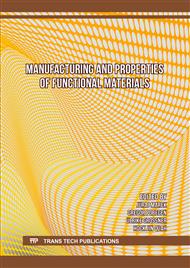[1]
K. Ullakko, J. Huang, C. Kantner, R. Handley, V. Kokorin, Large magnetic-field induced strain sin Ni2Mn Ga single crystals, Applied Physics Letters, (1996), 69, 1966-1968.
DOI: 10.1063/1.117637
Google Scholar
[2]
P. Zheng, P. Lindquist, B. Yuan, P. Müllner, D. Dunand, Fabricating Ni-Mn-Ga microtubes by diffusion of Mn and Ga into Ni tubes, Intermetallics, (2014), 49, 70-80.
DOI: 10.1016/j.intermet.2014.01.014
Google Scholar
[3]
R. Chulist, E. Pagounis, P. Czaja, N. Schell, H. Brokmeier, New Insights into the inter martensitic transformation and over 11 % magnetic-field-induced strain in 14 m Ni−Mn−Ga martensite, Advanced Engineering Materials, (2021), 23, 2100131(1-6).
DOI: 10.1002/adem.202100131
Google Scholar
[4]
J. Pons, V. Chernenko, R. Santamarta, E. Cesari, Crystal structure of martensitic phases in Ni-Mn-Ga shape memory alloys, Acta Materialia, (2000), 48, 3027-3038.
DOI: 10.1016/s1359-6454(00)00130-0
Google Scholar
[5]
A. Likhachev, K. Ullakko, Magnetic-field-controlled twin boundaries motion and giant magneto-mechanical effects in Ni-Mn-Ga shape memory alloy, Physics Letters A, (2000), 275, 142-151.
DOI: 10.1016/s0375-9601(00)00561-2
Google Scholar
[6]
I., Kulagin, M. Li, L. Ville, H. Heikki, Review of MSM actuators: applications, challenges, and potential, IEEE Access, (2022), 10, 83841-83850.
DOI: 10.1109/access.2022.3197278
Google Scholar
[7]
U.Gaitzsch, J. Drache, K. Mcdonald, P. Müllner, P. Lindquist, Obtaining of Ni-Mn-Ga magnetic shape memory alloy by annealing electrochemically deposited Ga / Mn / Ni layers, Thin Solid Films, (2012), 522, 171-174.
DOI: 10.1016/j.tsf.2012.08.019
Google Scholar
[8]
H. Lei, L. Tong, Z. Wang, Effect of temperature on magnetic field – induced response of Ni-Mn-Ga single crystals, Journal of Intelligent Material Systems and Structures, (2015), 26, 2395-2410.
DOI: 10.1177/1045389x14556164
Google Scholar
[9]
P. Polyakov, V. Slyusarev, V. Kokorin, S. Konoplyuk, Y. Semenova, V. Khovaylo, Volume change during intermartensitic transformations in Ni-Mn-Ga alloy, Journal of Materials Engineering and Performance, (2014), 23, 3180-3183.
DOI: 10.1007/s11665-014-1095-4
Google Scholar
[10]
D. Dunand, P. Müllner, Size effects on magnetic actuation in Ni-Mn-Ga shape memory alloys, Advanced Materials, (2011), 23, 216-232.
DOI: 10.1002/adma.201002753
Google Scholar
[11]
B. Özkale, F. Mushtaq, J. Fornell, G. Chatzipirpiridis, L. Martin, J. Sort, C. Müller, E. Pellicer, B. Nelson, S. Pané, Single step electrosynthesis of NiMnGa alloys, Electrochimica Acta, (2016), 204, 199-205.
DOI: 10.1016/j.electacta.2016.04.071
Google Scholar
[12]
K. Javed, X. Zhang, S. Parajuli, S.Ali, N.Ahmad, S.Shah, M. Irfan, J.Feng, Magnetization behavior of NiMnGa alloy nanowires prepared by DC electrodeposition, Journal of Magnetism and Magnetic Materials, (2020), 498, 166232.
DOI: 10.1016/j.jmmm.2019.166232
Google Scholar
[13]
Y. Zhang, F. Qin, D. Estevez, V. Franco, H. Peng, Structure, magnetic and magnetocaloric properties of Ni2MnGa Heusler alloy nanowires, Journal of Magnetism and Magnetic Materials, (2020), 513, 167100.
DOI: 10.1016/j.jmmm.2020.167100
Google Scholar
[14]
S. Hutagalung, M. Fadhali, R. Areshi, F. Tan, Optical and electrical characteristics of silicon nanowires prepared by electroless etching, Nanoscale Research Letters, (2017), 12, 425-436.
DOI: 10.1186/s11671-017-2197-3
Google Scholar
[15]
V. Laitinen, A. Saren, A. Sozinov, K. Ullakko, Giant 5.8 % magnetic-field-induced strain in additive manufactured Ni-Mn- Ga magnetic shape memory alloy, Scripta Materialia, (2022), 208, 114324 (2022).
DOI: 10.1016/j.scriptamat.2021.114324
Google Scholar
[16]
A. Mostafaei, K. Kimes, E. Stevens, J. Toman, Y. Krimer, K. Ullakko, M. Chmielus, Microstructural evolution and magnetic properties of binder jet additive manufactured Ni-Mn-Ga magnetic shape memory alloy foam, Acta Materialia, (2017), 131, 482-490.
DOI: 10.1016/j.actamat.2017.04.010
Google Scholar
[17]
A. Smith, J. Tellinen, K. Ullakko, Rapid actuation and response of Ni-Mn-Ga to magnetic-field-induced stress, Acta Materialia, (2014), 80, 373-379.
DOI: 10.1016/j.actamat.2014.06.054
Google Scholar
[18]
K. Ullakko, Magnetically controlled shape memory alloys: a new class of actuator materials, Journal of Materials Engineering and Performance, (1996), 5, 405-409.
DOI: 10.1007/bf02649344
Google Scholar
[19]
K.Ullakko, L. Wendell, A. Smith, P. Müllner, G. Hampikian, A magnetic shape memory micropump: contact-free, and compatible with PCR and human DNA profiling, Smart Materials and Structures, (2012), 21, 115020 (1-10).
DOI: 10.1088/0964-1726/21/11/115020
Google Scholar
[20]
A. Saren, D. Musiienko, A. Smith, J. Tellinen, K. Ullakko, Modeling and design of a vibration energy harvester using the magnetic shape memory effect, Smart Materials andStructures, (2015), 24, 95002.
DOI: 10.1088/0964-1726/24/9/095002
Google Scholar
[21]
V. Lindroos, M. Tilli, A. Lehto, T. Motooka, Handbook of Silicon Based MEMS Materials and Technologies, William Andrew, (2010), 636 .
Google Scholar
[22]
H. Qu, CMOS MEMS fabrication technologies and devices, Micromachines, (2016), 7, 1-21.
Google Scholar
[23]
R.A. Moghadam, H. Saffari, J. Koohsorkhi, Ni–P electroless on nonconductive substrates as metal deposition process for MEMS fabrication, Microsystem Technologies, (2021), 27, 79-86.
DOI: 10.1007/s00542-020-04912-8
Google Scholar
[24]
R. Anthony, N. Wang, D. Casey, C. Mathúna, J. Rohan, MEMS based fabrication of high-frequency integrated inductors on Ni-Cu-Zn ferrite substrates, Journal of Magnetism and Magnetic Materials, (2016), 406, 89-94.
DOI: 10.1016/j.jmmm.2015.12.099
Google Scholar
[25]
A. Algamili, M. Khir, J. Dennis, A. Ahmed, S, Alabsi, S.B. Hashwan, M. Junaid, A review of actuation and sensing mechanisms in MEMS-based sensor devices, Nanoscale Research Letters, (2021), 16, 1-21.
DOI: 10.1186/s11671-021-03481-7
Google Scholar
[26]
X.Zhang, M. Qian, Magnetic shape memory alloys - preparation, martensitic transformation and properties, Harbin Institute of Technology Press, (2022), 1200.
Google Scholar
[27]
K. Williams, R. Muller, Etch rates for micromachining processing, Journal of Microelectromechanical Systems, (1996), 5, 256-269.
DOI: 10.1109/84.546406
Google Scholar
[28]
K. Williams, K. Gupta, M. Wasilik, Etch rates for micromachining processing - Part II, Journal of Microelectromechanical Systems, (2003), 12, 761-778.
DOI: 10.1109/jmems.2003.820936
Google Scholar
[29]
B. Wu, A. Kumar, S. Pamarthy, High aspect ratio silicon etch: a review. Journal of Applied Physics, (2010), 108, 051101.
DOI: 10.1063/1.3474652
Google Scholar
[30]
K. Ullakko, Operation element comprising magnetic shape memory alloy and a method for manufacture it. U.S. Patent PCT/FI2019/050613, PAT 1388 WO.
Google Scholar


